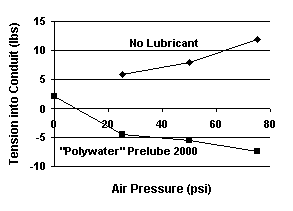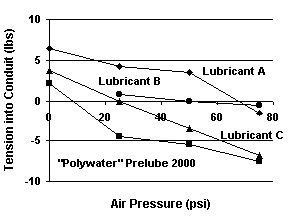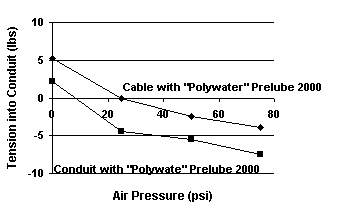| |
|||||||||
| |
|
|
|
|
|
|
|
||
| Home | About | Literature | Site Map | MSDS | Contact | Engineers | Shows | Links | Samples | RFQ | Catalog Numbers |

Some new and interesting installation methods are being used to put fiber optic cable in duct. Sometimes called "cable blowing," these methods use a high-volume air flow (200+ cfm and 100+ psi back pressure) to "push" the cable. Most blowing machines also have mechanical "pushing," where the cable is pushed by traction rollers as it enters the conduit. American Polywater completed a study of lubrication in high-speed air blowing and presented a paper on the subject at the NFOEC. Some data and results from this study are presented in this TeleTopics.
First, lets review the two basic types of blowing installation.
Piston Type
In this type of blowing unit, an air-tight piston is attached to the front of the cable. The air pushes this piston, and the piston "pulls" the cable. The pulling force is essentially the air pressure times the piston area. At 120 psi, the force can be 150 lbs for 1.25" innerduct and 850 lbs for 3" duct. Field users should be aware that a pulling force exists in piston blowing, and cable tension maximums should be respected.
Laminar Flow Type
The second type of blowing unit does not use a piston, and allows full air flow through the conduit. Calculations indicate that air speeds of 100+ mph are possible. This rushing air pushes on the cable jacket, providing a general force "all over" the jacket.
Mechanical "Pushing"
Pushing has always been an effective way to make short runs of cable in conduct. However, you can only push a cable to the point that it buckles, which can be less than 10 lbs for a flexible, indoor cable, and up to 75 lbs for an armored, outside-plant type cable. Even in straight ducts, pushing of typical outside plant cables is limited to a few hundred feet. This means the air forces, piston or laminar, are key to making blowing units function for the 3,000 - 5,000 foot runs typical in outside plant construction.
Air Tight Duct
Cable blowing machines don't work unless the duct is air-tight. Reinforced duct splices are usually required. Most cable blowing to date has been done in continuous polyethylene innerduct, which minimizes opportunities for air loss. It's a mistake to try to blow cable into a duct that has not been prepared for the pressures and forces involved.
Key Application Parameters
Fiber optic cable-blowing research indicates three major factors control how far a cable can be blown. These are:
American Polywater recently completed a series of experiments on high speed air blowing with a laminar flow unit. Coefficient of friction was studied. The results are useful to those blowing or planning on blowing cable. The tests demonstrate the superior performance of American Polywater's blowing lubricant, Polywater® Prelube 2000™.
Experimental Method
A special method was developed to measure friction in high speed air blowing. The tests were done with a laminar flow blowing unit, with the "mechanical pusher" disengaged. Cable was threaded thru a 300-foot multi-bend conduit run. The only force on the cable was from the air flow. This force was measured with a load cell. A positive force (+) indicates the cable had to be pushed to make it move. A negative force indicates the cable was "pulling" itself in, and if released, would "blow" into the conduit on its own.
The air flow to the blowing unit could be increased to the compressor maximum capacity of 365 cfm. In the relatively short 300-foot run of 1.25" smoothwall innerduct, this flow produced 75 psi back-pressure. The air was regulated to pressures of 0, 25, 50, and 75 psi. 0 (zero) psi means that no air was on. 0 psi is really a measure of the pushing force it takes to move the cable without air.
Unlubricated versus Lubricated
Graph 1 shows data for unlubricated duct versus Prelube 2000™ coated on the duct wall. Without PL-2000™, the cable had to be "pushed" to get movement. However, the PL-2000™ resulted in the cable "pulling itself" with up to 10 lbs of force. To provide perspective, the cable would race into the duct at over 500 feet/min if we let it go at the -10 lb level of pull. Remember that the minus (-) means the air flow was making the cable pull on the load measuring cell.

Different Lubricants
Polywater® Prelube 2000™ is not a cable pulling lubricant. It was developed specifically for conduit prelubrication during cable blowing.
There is some indication that conventional pulling lubricants are not as effective as blowing lubricants. Graph #2 compares the Prelube 2000™ to several other lubricants. In all cases, the PL-2000™ is notably better.

Lubricating Conduit vs Cable
Graph #3 shows an interesting and unexpected result from the testing. In one case, the PL-2000™ was applied to the interior of the duct (by blowing through a coating missile before blowing the cable). This is contrasted with PL-2000™ coated on both the duct and cable. Coating the conduit only is more effective! We believe this indicates the cable jacket should not be "slippery" for optimal laminar-flow blowing. Remember, the air "pushes" on the jacket--through friction. A low friction jacket may not be as easy for air to push.

Field Prelubrication versus Factory Lubricated Duct
The study indicates that field lubrication of plain duct is just as effective, and sometimes more effective, than duct lubricated when it's extruded. The field prelubrication process, with a high volume compressor, only takes a few minutes. The lubricant is fresh and ready to go.
The use of Polywater® Prelube 2000™ can cost 90% less than factory-lubricated ducts! On typical fiber optic conduits, optimal coating of PL-2000™ is in the .2 to .3 cent per foot range, versus a factory prelubricated premium of 2 to 10 cents/ft. The use of plain duct coated with PL-2000™ has enormous cost savings potential on large jobs.
Samples for Trial
There are numerous factors in cable blowing that were not studied. Besides cable/conduct size and cable flexibility, temperature and conduit internal design (smooth, ribbed, corrugated, etc.) are known influences. The manufacturers of blowing equipment have some information on these variables and optimizing the blowing environment.
American Polywater is developing state-of-the-art lubrication products for air blowing cable. If you would like to try a sample of the PL-2000™, please call our customer service at 800-328-9384 (1-651-430-2270 internationally). We'd be happy to work with you in evaluating this new technology and product.
American Polywater also offers a software program called the Pull-Planner™ that provides a convenient way to estimate cable pulling lubricant requirements (and much more) on a personal computer. Click here to order the software for $129, or contact American Polywater's Technical Service Department at 1-800-328-9384 if you have questions or wish to order over the phone.
View this article En Español!
View this article in PDF Format
Click here to view an OSP Magazine Article Reprint on cable blowing
Free 12-minute training video on Fiber Optic Cable Pulling & Lubrication
For Subscriptions, Comments, or Questions contact: tteditor@polywater.com
Home |
About |
Site Map |
Literature |
Samples |
Links |
Reps |
Videos |
Pumps |
RFQ
Codes |
Engineering |
Shows |
Spotlight |
Newsletters |
MSDS |
Translations |
Contacts |
Jobs

11222 60th ST N | Stillwater, MN 55082-9310 USA
1-(651) 430-2270 (Voice) | 1-(651) 430-3634 (Fax)
1-(800) 328-9384 (Toll-Free US/Canada Only)
Copyright © 2001 - 2015 American Polywater Corporation | ![]() 6/5/15
6/5/15